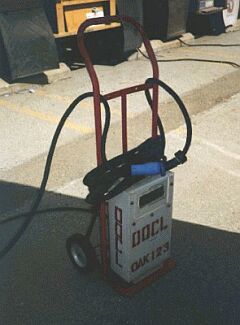The containers are classified according to two types of network voltage, with a further division made according to the network frequency.
It must be possible to operate type 1 containers on the following power networks:
| a) | 50 Hz +/- 2.5%: | 180 V min. | 230 V max. |
| b) | 60 Hz +/- 2.5%: | 200 V min. | 250 V max. |
It must be possible to operate type 2 containers on the following power networks:
| a) | 50 Hz +/- 2.5%: | 360 V min. | 460 V max. |
| b) | 60 Hz +/- 2.5%: | 400 V min. | 500 V max. |
There are also containers fitted with dual-voltage systems which allow them to be operated in both voltage ranges. These containers have an additional transformer that is used to convert the network voltage to the relevant operating voltage. A dual-voltage system such as this is optional. The weight of the refrigeration unit increases as a result of the transformer and the second connection cable. As an alternative, mobile transformers are occasionally used at terminals (see Fig. 29).
A general rule is that the maximum power consumption is not permitted to exceed 15 kW or 18.75 kVA. The make current is not permitted to exceed 300 A for type 1 containers and 150 A for type 2 containers. The make current can be reduced by starting the motors sequentially. The make current must fall to to 125% of the rated current within one second.
 |
Figure 29: Mobile transformer used to provide refrigerated containers with 240 V 3-phase power |
The insulation resistance to ground must be at least 1 MΩ. The protection class is IP56.
At the moment the responsible ISO committee is working on specifying a maximum leakage current for refrigerated containers. The limit should be around 20 mA. This value appears to be problematic insofar as the defrosting heaters in the evaporator are unable to meet these values after a long standstill, but dry out once they have started operating, thus increasing the insulation resistance.